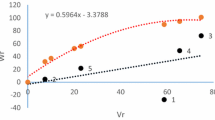Abstract
Present study carried out in a randomized complete block design with three replications for determining additive, dominance and cytoplasmic effects on inheritance of yield and some of agro-morphological traits in bread wheat. The highest value of grain yield (265.5 g m–1) was obtained in p6. Dominance variance was larger than additive variance for grain-filling period (GFP), plant height (PH), spike length (SL), flag leaf exit (FLE), canopy temperature (CT), early growth vigor (EGV), grain length (GL) and thousand-grain weight (TGW). Whereas, the additive variance was larger than dominance one for days to heading (DH), days to maturity (DM), peduncle length (PL), SPAD and grain yield (GY). Therefore, for these traits selection in early breeding generations could be effective to bring positive changes in these traits. There were significantly positive additive effects (A) of P1 on GFP, CT, GL and TGW; of P3 on DH and DM; P4 on PL, FLE, SPAD and GY and of P6 on PH, SL and EGW. The crosses containing g3 × g4, g4 × g5 and g4 × g6 were indicated positive and significant heterosis for grain yield. P6 were desirable parent for reducing days to heading and maturity and increasing plant height, spike length and early growth vigor.
Similar content being viewed by others
REFERENCES
Iran-Nejad, H. and Shahbaziyan, N., Wheat, vol. 1: Cereal Cultivation, Tehran: Karenoo Publications, 2005.
Chowdhry, M.A., Ambreen, A., and Khaliq, I., Genetic control of some polygenic traits in Aestivum species, Asian J. Plant Sci., 2002, vol. 1, no. 3, pp. 235–237.
Kumar, A., Mishra, V.K., Vyas, R.P., and Singh, V., Heterosis and combining ability analysis in bread wheat (Triticum aestivum L.), J. Plant Breed. Crop Sci., 2011, vol. 3, no. 10, pp. 209–217.
Zhu, J. and Weir, B.S., Analysis of cytoplasmic and maternal effects: I. A genetic model for diploid plant seeds and animals, Theor. Appl. Genet., 1994, vol. 89, pp. 153–159.
Joshi, S.K., Sharma, S.N., Singhania, D.L., and Sain, R.S., Combining ability in the F1 and F2 generations of diallel cross in hexaploid wheat (Triticum aestivum L. em. Thell), Hereditas, 2004, vol. 141, pp. 115-121.
Inamullah, A., Mohammad, H., Siraj-ud-Din, F., Hassan, G., and Gul, R., Evaluation of the heterotic and heterobeltiotic potential of wheat genotypes for improved yield, Pak. J. Bot., 2006, vol. 38, pp. 1159–1167.
Zhu, J. and Weir, B.S., Diallel analysis for sex-linked and maternal effects, Theor. Appl. Genet., 1996, vol. 92, pp. 1–19.
Zhu, J. and Weir, B.S., Analysis of cytoplasmic and maternal effects: II. Genetic models for triploid endosperms, Theor. Appl. Genet., 1994, vol. 89, pp. 160–166.
Iqbal, M., Fayyaz, M., Shahzad, A., Ahmed, I., Ali, G.M., Masood, S., and Spaner, D., Effect of vernalization on grain fill duration and grain weight in spring wheat, Pak. J. Bot., 2011, vol. 43, no. 1, pp. 689–694.
Ahmad, M., Iqbal, M., Shahzad, A., Asif, M., and Sajad, M., Genetic analysis of yield and yield contributing quantitative traits in bread wheat under sodium chloride salinity, J. Agric. Sci., 2013, vol. 5, no. 6, pp. 156–163.
Iqbal, M., Navabi, A., Salmon, D.F., Yang, R., Murdock, B.M., Moore, S.S., and Spanner, D., Genetic analysis of flowering and maturity time in high latitude spring wheat, Euphytica, 2007, vol. 154, pp. 207–218.
Jiang, X., Wu, P., and Tian, J., Genetic analysis of amino acid content in wheat grain, J. Genet., 2014, vol. 93, no. 2, pp. 451–458.
Yıldırım, M., Kılıc, H., Kendal E., and Karahan, vol. T. Applicability of chlorophyll meter readings as yield predictor in durum wheat, J. Plant Nutr., 2011, vol. 34, no. 2, pp. 151–164.
Zhu, J., Mixed model approaches for estimating variances and covariances, Chin. J. Biomed., 1992, vol. 7, pp. 1–11.
Rao, C.R., Estimation of variance and covariance components-MINQUE theory, J. Mult. Anal., 1971, vol. 1, pp. 257–275.
Chen, G. and Zhu, J., QGAStation 1.0. Software for the Classical Quantitative Genetics, Institute of Bioinformatics, Zhejiang University, 2003.
Dreisigacker, S., Melchinger, A.E., Zhang, P., Ammar, K., Flachnecher, C., Hoisington, D., and Warburton, M.L., Hybrid performance and heterosis in spring bread wheat, and their relations to SSR-based genetic distances and coefficients of parentage, Euphytica, 2005, vol. 144, pp. 51–59.
Dhanda, S.S., Sethi, G.S., and Behi, K.K., Inheritance of seedling traits under drought stress conditions in bread wheat, Cereal Res. Commun., 2002, vol. 30, nos. 3–4, pp. 293–300.
Singh, R.K. and Chaudhary, B.D., Biometrical Methods in Quantitative Genetic Analysis, New Delhi: Kalyani Publishers, 1995.
Farshadfar, E., Farshadfar, M., and Sutka, J., Combining ability analysis of drought tolerance in wheat over different water regimes, Acta Agron. Hung., 2000, vol. 48, no. 4, pp. 353–361.
Lin, J., Shi, C.H., Wu, M., and Wu, J., Analysis of genetic effects for cooking quality traits of japonica rice across environments, Plant Sci., 2005, vol. 168, pp. 1501–1506.
Yagdi, K., Path coefficient analysis of some yield components in durum wheat (Triticum durum Desf.), Pak. J. Bot., 2009, vol. 41, pp. 745–751.
Yıldırım, M., Akıncı, C., Koc M., and Barutc, C. Applicability of canopy temperature depression and chlorophyll content in durum wheat breeding, Anadolu J. Agric. Sci., 2009, vol. 24, no. 3, pp. 158–166.
Ginkel, M., Reynolds, M.P., Trethowan, R., and Hernandez, E., Can canopy temperature depression measurements help breeders in selecting for yield in wheat under irrigated production conditions?, Proceedings of the 4th International Crop Science Congress, Brisbane, 2004.
Author information
Authors and Affiliations
Corresponding author
Ethics declarations
Conflict of interest. The authors declare that they have no conflict of interest.
Statement of welfare of animals. All applicable international, national, and/or institutional guidelines for the care and use of animals were followed. The article does not concern any researches using animals as objects.
About this article
Cite this article
Rahmatallah Karimizadeh, Sharifi, P. & Mohtasham Mohammadi Genetic Analysis of Morphological Traits in Wheat Hybrids Based on the Additive-Dominance Model. Russ. Agricult. Sci. 46, 113–120 (2020). https://doi.org/10.3103/S1068367420020160
Received:
Published:
Issue Date:
DOI: https://doi.org/10.3103/S1068367420020160



